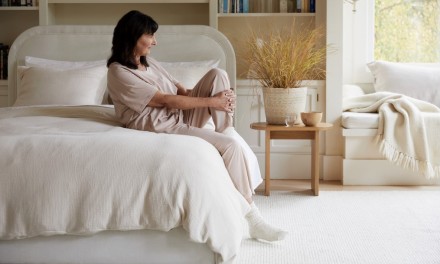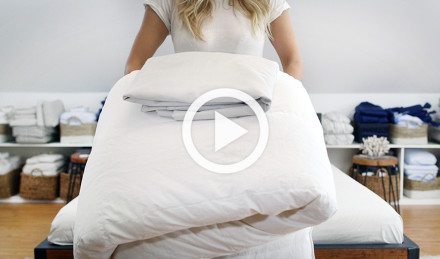Fresh sheets are one of life's simplest pleasures. While a brand-new set is always nice, the crisp, clean feel of just-washed bedding is pretty amazing too.
White bed linens are not only classic but also seasonless and endlessly versatile. The trouble is, it's hard to make light-colored fabric look clean, even when it technically is clean. If you're wondering how to whiten sheets and prevent discoloration, you've come to the right place.
Find tips and techniques for whitening sheets below, along with step-by-step guidance on how to wash white sheets with different products.
What Products Can You Use to Keep White Sheets White?
What Products Can You Use to Keep White Sheets White?
It's normal for bedding to become slightly dingy as sweat and body oils accumulate over time. But unfortunately, white fabrics tend to discolor quicker than others. Beyond affecting the aesthetic of your perfectly layered bed, this can be an issue when you don't have any clean-looking bed linens for overnight guests.
Though regular laundering is important, you'll want to be careful about overwashing, as it can wear down the material prematurely. That said, there are a few products you can use to keep sheets whiter longer without affecting the integrity of the fabric. These include OxiClean, borax, baking soda, vinegar, lemon juice and hydrogen peroxide. Read on for details.
How to Brighten White Sheets With OxiClean
When it comes to stain removal, spot-cleaning and brightening dulled fabrics, Parachute is a fan of OxiClean — a type of oxygenated bleach. The brand's White Revive product in particular is great for whitening sheets without traditional chlorine bleach.
Here's how to whiten sheets with OxiClean:
Submerge your sheets in warm water, either in a designated basin, a bathtub or your washing machine.
Add a capful of OxiClean per gallon of water.
Let your sheets soak for about six hours.
Wash your sheets as you normally would with regular detergent and maybe another capful of OxiClean for good measure.
Soaking your sheets can help brighten the material and address yellowing caused by sweat. You're also wise to use about a capful of this product each time you launder your bedding.
Though OxiClean is great for those who want to whiten sheets without bleach, bear in mind it's not recommended for silk, wool and dry-clean-only textiles. But since it doesn't contain chlorine, you can use it to brighten most other colored fabrics.
See our guide on How to Wash and Care for Silk before cleaning this delicate material.
Whitening Sheets With Borax
You can also wash white sheets with borax. Also known as sodium borate, the natural mineral compound is a powdery substance containing salt, boron and oxygen.
Here's how to whiten sheets with borax:
Submerge your bed sheets in warm water, either in a bathtub, a designated basin or your washing machine.
Add about a half-cup of borax per gallon of water.
Let your sheets soak in the solution overnight.
Machine-wash your sheets as usual with laundry detergent.
Exposing fabrics to this mineral substance for several hours can remove stains, yellowing and discoloration. You can also add up to a cup of borax to your regular loads of laundry for extra cleaning power. But keep in mind the powder won't dissolve as well in cold water, so select a warm cycle to ensure no white flecks are left behind.
Beyond its natural whitening abilities, you can use borax to soften hard water, which is sometimes a culprit of dingy, discolored fabrics. This all-star product may also inhibit mold growth and help neutralize musty odors.
See our Fabric and Bedding Materials Guide for detailed information about different household textiles.
Washing Sheets with Baking Soda and Vinegar
Did you know you can whiten sheets with baking soda and distilled white vinegar? These household products work surprisingly well at cleaning all types of materials and surfaces, and cotton bedding is no exception.
Here's how to wash white sheets with baking soda and vinegar:
Fill your washing machine with cold or warm water.
Add about a half-cup of baking soda to the drum, then pour the vinegar into the fabric softener dispenser up to the fill line.
Place your sheets in the drum, add about a quarter-cup of laundry detergent and run them on a normal wash cycle.
Another option is to soak your bedding for a few hours in a solution of distilled white vinegar and baking soda. (Add about a half-cup of each for every gallon of water).
Washing sheets with vinegar can leave them with an acidic smell, but since baking soda is a natural odor-neutralizer, this may not be an issue. Air-drying your bedding can also help minimize the vinegary smell.
Working with organic fabrics? Here's How to Wash, Dry and Care for Organic Cotton Sheets, Towels and Clothes.
Making Yellowed Sheets White Again With Lemon Juice
If you prefer all-natural cleaning solutions, this one's for you. Though the yellow hue of lemon peels is a color you're looking to avoid, the citric acid found in lemon juice is a natural bleaching agent, meaning it can whiten fabrics.
Here's how to whiten sheets with lemon juice:
Juice one lemon, removing the seeds and pulp.
Pour the lemon juice into your washing machine along with your regular laundry detergent.
Add your sheets and run the wash cycle as you normally would.
You can also create a DIY whitening solution with warm water and lemon juice, mixing about a half-cup of juice per gallon of water. Let your sheets soak in the mixture for at least a couple of hours or as long as overnight for more stubborn stains. Then machine-wash them as usual. You'll be left with naturally clean, bright bedding and a nice citrus scent.
How to Wash White Sheets With Hydrogen Peroxide
Hydrogen peroxide is another multi-use product that works surprisingly well at whitening sheets.
Here's how to whiten sheets using this all-purpose antiseptic:
Pour about a cup of hydrogen peroxide into your washing machine, along with a normal amount of laundry detergent. (You can also add it to the bleach dispenser or put baking soda in the fabric softener dispenser for a little extra cleaning power.)
Place your sheets in the drum.
Select a normal cycle with warm water and wash as usual.
Though hydrogen peroxide is considered a bleaching agent, you can use it in small amounts to brighten colored fabrics — similar to OxiClean and other oxygenated bleaches.
Whitening Sheets With Bleach: What to Consider
Chlorine bleach, whether in liquid or powder form, can effectively whiten sheets. However, this cleaning agent is notably harsh on fabrics and potentially toxic if inhaled or ingested in large amounts. It can also irritate the eyes and skin.
If you like white sheets, why not go all out? Here's How to Design and Style a White Bedroom.
Best Practices for Washing and Drying White Bed Sheets
Best Practices for Washing and Drying White Bed Sheets
Knowing what products to use to get white sheets white again is crucial, but it's only part of the equation. Properly washing your bedding on a regular schedule will help you maintain a hotel-quality look and feel. Let's go over the general guidelines of how to clean white sheets.
Wondering how to wash your other sheets? Check out our article on How to Wash Sheets the Right Way: Step-by-Step Instructions
How to Wash White Sheets
For regular washing, follow these steps.
Pre-soak your sheets for roughly an hour in the washing machine using warm water and your preferred whitening agent, such as OxiClean, borax, baking soda, distilled white vinegar, lemon juice or hydrogen peroxide.
After draining the pre-soak solution, add mild laundry detergent to the drum.
Choose a normal, delicate or bedding-specific cycle with warm or cold water, then press start.
If possible, it's best to let the laundry soap dissolve completely before adding your sheets. (This may be harder to do if you pre-soaked them in the drum.) When in doubt, refer to the brand's care instructions.
How Often Should I Wash Cotton Sheets? Read our blog to find out.
Drying White Sheets
You can tumble-dry most sheets in a standard dryer, but if you want wrinkle-free bedding, try not to load it more than half full. This will prevent twisting and allow the fabric to fluff up while it dries.
Low heat is recommended. While you don't have to worry about fading white sheets, higher heats can prematurely wear down the textile's fibers. A natural, eco-friendly alternative to dryer sheets, wool dryer balls can also help minimize static cling and soften your bedding.
Pulling your sheets out a few minutes early and making your bed when the fabric is about 95% dry can help you avoid wrinkles while cutting down on your energy use. Air-drying your sheets, even just partially, can help you reduce your carbon footprint as well.
Do Dryer Balls Really Work? Read our blog for insight into these sustainable laundry companions.
Whitening Sheets FAQs
Find answers to frequently asked questions about whitening discolored sheets below.
Why Are My White Sheets Turning Yellow?
In most cases, perspiration is the culprit of yellow stains on white sheets. Sweat is a blend of water, urea, salt, ammonia and natural sugars. When the mixture reacts with bacteria and chemicals in laundry detergent, it can turn a golden-brown or yellowish hue. Get help finding the right sheets to reduce sweating here: Best Sheets for Night Sweats.
Oils can also cause discoloration, whether naturally produced by your body or from products you apply to your skin. Not all stains are unavoidable, but going to bed with a freshly washed face can help prevent yellowing.
White bedding isn't for everyone, but what hue should you choose? See our article to find The Right Bedroom Color for You.
How Do You Prevent White Sheets From Turning Yellow?
The best way to prevent yellowing is to wash white sheets regularly — about once a week is ideal. If needed, you can also pre-soak your bedding before each wash with a chlorine-free bleaching agent like OxiClean, hydrogen peroxide, lemon juice, borax, baking soda or distilled white vinegar.
As mentioned, going to bed with clean, makeup-free skin can also help keep streaks and stains at bay.
Can You Wash White Sheets With Colored Laundry?
Mixing colors in the laundry can dull white sheets. To prevent a greyish, dingy hue, it's best to separate your whites from your brights and darks. A top sheet, a fitted sheet and two pillowcases is often a large enough load as is, especially if you want to avoid twisting in the dryer. So unless you have a few white t-shirts sitting around that need cleaning, wash your sheet set on its own.
Believe it or not, white is an excellent year-round choice for bedding, even in the chilliest season. See our blog for tips on Layering Winter Whites.
Can You Whiten Bed Pillows?
Whitening Sheets FAQs
Find answers to frequently asked questions about whitening discolored sheets below.
Why Are My White Sheets Turning Yellow?
In most cases, perspiration is the culprit of yellow stains on white sheets. Sweat is a blend of water, urea, salt, ammonia and natural sugars. When the mixture reacts with bacteria and chemicals in laundry detergent, it can turn a golden-brown or yellowish hue. Get help finding the right sheets to reduce sweating here: Best Sheets for Night Sweats.
Oils can also cause discoloration, whether naturally produced by your body or from products you apply to your skin. Not all stains are unavoidable, but going to bed with a freshly washed face can help prevent yellowing.
White bedding isn't for everyone, but what hue should you choose? See our article to find The Right Bedroom Color for You.
How Do You Prevent White Sheets From Turning Yellow?
The best way to prevent yellowing is to wash white sheets regularly — about once a week is ideal. If needed, you can also pre-soak your bedding before each wash with a chlorine-free bleaching agent like OxiClean, hydrogen peroxide, lemon juice, borax, baking soda or distilled white vinegar.
As mentioned, going to bed with clean, makeup-free skin can also help keep streaks and stains at bay.
Can You Wash White Sheets With Colored Laundry?
Mixing colors in the laundry can dull white sheets. To prevent a greyish, dingy hue, it's best to separate your whites from your brights and darks. A top sheet, a fitted sheet and two pillowcases is often a large enough load as is, especially if you want to avoid twisting in the dryer. So unless you have a few white t-shirts sitting around that need cleaning, wash your sheet set on its own.
Believe it or not, white is an excellent year-round choice for bedding, even in the chilliest season. See our blog for tips on Layering Winter Whites.
Can You Whiten Bed Pillows?
Lots of folks wonder if they can whiten their bed pillows with the same methods used to bleach white sheets. Though some pillows can be machine-washed on a delicate cycle with cold water and mild detergent, others call for hand-washing or dry-cleaning only.
If your pillow is machine-washable, you might be able to use one of the whitening agents mentioned above to remove stains. Still, it's best to check the manufacturer's care instructions before trying to clean or bleach a bed pillow.
What style is right for you? See our article on How to Choose the Right Pillow for insight.
How Do Hotels Keep Sheets White?
Generally speaking, hotels use chlorine bleach to keep their sheets white. In fact, that’s often why hotels choose white bed linens, as other colors can't be bleached without causing discoloration.
While regular bleaching is the name of the game in the hospitality industry, it's not necessarily ideal for household use. The harsh substance can weaken fabric fibers, making bedding more prone to rips and tears.
For additional guidance, check out our article on How to Wash and Properly Care for Bedding.
When Is It Time to Replace My Bed Sheets?
When your efforts to whiten sheets don't get all the stains out, it might be time to think about getting a new set. The lifespan of your sheets depends on the material and how often you use them. If you sleep with the same set every single day, all four seasons, you'll need to replace it every couple of years.
However, sateen, percale and other luxury materials sourced from long-staple cotton fibers can offer another year or two of use. Linen is arguably the most durable bedding textile available, lasting up to five years — sometimes longer.
See our guide for a deeper dive into How Often to Replace Sheets, and check out these Bed Sheet Color Trends for tips on choosing a shade.
Where to Buy High-Quality Bedding
When the time comes to buy new bedding, you can't go wrong with Parachute. In addition to high-quality sheets in chic, modern colors, you'll find pillowcases, shams, duvet covers, blankets and inserts.
Parachute carries all the best naturally sourced fabrics, including percale, sateen, brushed cotton, linen and organic cotton, all ethically made and Oeko-Tex certified. Shop the collections today!
Read Next:
Where to Buy High-Quality Bedding
When the time comes to buy new bedding, you can't go wrong with Parachute. In addition to high-quality sheets in chic, modern colors, you'll find pillowcases, shams, duvet covers, blankets and inserts.
Parachute carries all the best naturally sourced fabrics, including percale, sateen, brushed cotton, linen and organic cotton, all ethically made and Oeko-Tex certified. Shop the collections today!
Read Next:













